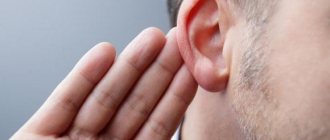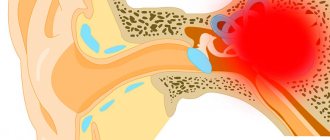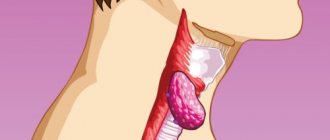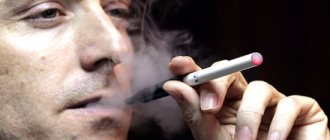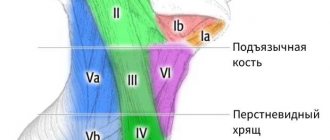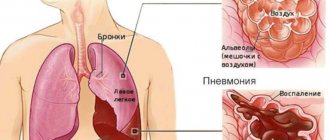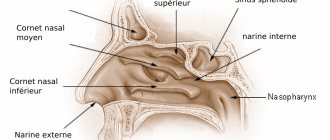Trigeminal neuritis is sometimes mistakenly called trigeminal neuritis of the facial nerve, but more often another term is used - “neuralgia” - which literally means pain. This is an inflammatory process in the fifth pair of cranial nerves.
Our expert in this field:
Kamyshev Lev Gennadievich
Manual therapy doctor, neurologist
Call the doctor
Some facts about the disease:
- On average, it occurs in 6-8 people out of every 100,000.
- Women get sick more often than men.
- In most cases, the disease is diagnosed in people over 40-50 years of age.
There are two types of trigeminal neuralgia:
- Primary occurs as an independent disease.
- Secondary – a symptom of other pathologies.
How does the trigeminal nerve work?
The trigeminal nerve is the fifth pair of cranial nerves (there are 12 pairs in total - they innervate the organs of the head and neck). It is paired - that is, it is on the right and left. It consists of two types of nerve fibers - sensory and motor. After exiting the skull, the trigeminal nerve divides into three branches, which seem to cover the entire face:
- Ocular - is sensitive, innervates the eyeballs, eyelids, lacrimal sacs, mucous membrane of the nose and its paranasal sinuses, lacrimal gland, forehead skin.
- Maxillary - also sensitive, innervates the skin of the cheek, temple, teeth and gums of the upper jaw, mucous membrane of the palate, nose.
- Mandibular - responsible for both sensitivity and movement, innervates the muscles of mastication, muscles of the palate, eardrum, mucous membrane of the cheek, anterior 2/3 of the tongue, skin of the temple, the front of the ear and external auditory canal, teeth and gums of the lower jaw.
Treatment of trigeminal neuritis
Typically, treatment of the disease begins with medications:
- Anticonvulsants . Usually the drug carbamazepine or phenytoin, oxcarbazepine is prescribed; the doctor selects the dose individually. Over time, these medications may become less effective, in which case your doctor will increase the dosage. However, anticonvulsants have some side effects that may make it difficult to use them.
- Antispasmodics . Used together with anticonvulsants. For example, a neurologist may prescribe baclofen for you.
- Physiotherapy . Diadynamic currents, ionogalvanization with novocaine, and ultraphonophoresis with hydrocortisone help to cope with the symptoms of trigeminal neuritis.
If neuralgia manifests itself in the form of severe toothaches, painkillers are used, and ointments with anesthetics are rubbed into the gums.
If medications no longer help, the neurologist raises the question of surgical treatment of trigeminal neuritis. The following operations are possible:
- Microsurgical decompression . During the intervention, compression of nerve fibers by blood vessels is eliminated. Typically the incision is made behind the ear. The operation effectively eliminates pain, but after it a relapse may occur, complications such as hearing loss, numbness of the face, paresis and paralysis of the facial muscles.
- Transection of nerve branches . In this case, the transmission of pain impulses is disrupted.
- Radiosurgery (gamma knife). A special device generates a high dose of ionizing radiation, which damages nerve fibers. If painful attacks begin to bother you again in the future, the procedure can be repeated.
There are other surgical methods for treating this type of neuritis.
We will call you back
Leave your phone number
The trigeminal nerve provides sensation to the skin of almost the entire face and front of the head. It is mixed in structure, that is, it is responsible for both sensitivity and movement, but the motor fibers are thinner. Still, the trigeminal nerve is mostly sensitive. This determines the characteristics of the symptoms of the disease.
Treatment options
In medicine, there are several ways to treat trigeminal nerve inflammation, depending on the severity of the disease. Before treating a pathology, specialists identify the exact cause of the disease and only then prescribe the appropriate method.
This can be complex therapy that prevents the development of a chronic form, surgery, or taking medications.
Video:
In milder forms, doctors prescribe a massage for the affected areas of the face, in combination with special therapies.
Drug therapy
Drug treatment is based on taking anti-inflammatory drugs and tablets that can relieve pain and eliminate the cause.
The most commonly prescribed medication is carbamazepine (also known as finlepsin). The medicine is an anticonvulsant drug that inhibits neuronal activity.
Its dosage regimen consists of gradually increasing the dose, starting from the minimum level. Over time, it is gradually increased, but the maximum dosage should not exceed 1200 mg per day.
Even after achieving a therapeutic effect, medication use is extended for up to 8 weeks.
READ What is a radicular cyst and how to treat it?
Along with it, concomitant or alternative drugs are also prescribed: nicotinic acid, gabapentin, neuromultivitis and special injection injections.
It is more convenient to divide the remaining medications into categories, in accordance with the principle of action:
- Antiviral - prescribed when inflammation occurs due to a viral or bacterial basis. This category includes various antibiotics, such as flemoxin, nimesulide.
- Non-steroidal and painkillers: movalis, mydocalm, glycine, nimesil. They have a short course of treatment because they can cause problems with the intestinal tract, so they only help at the very beginning.
- Painkillers in the form of analgesics: menovazine, ketanov. The drugs are prescribed for severe pain.
- Neuroprotectors and vitamins: atarax, amitriptyline, milgamma, neurodiclovit. Reduce nervousness and further disorders of the nervous system.
- Glucocorticoids – dimethyl sulfoxide, methylprednisolone, prednisolone. Fast-acting medications that relieve swelling.
- Ointments and gels: star balm, ketonal, dimexide. They help relieve swelling, swelling and other neoplasms due to the course of the disease.
All prescribed medications must be used strictly as prescribed by the doctor and in accordance with the prescribed dosage regimen. Overdose aggravates the situation and causes side effects that can affect the entire nervous system and affect the brain.
Carrying out the operation
Medications are not always able to cure inflammation of the trigeminal nerve, especially in more severe forms, and then the surgical method comes to the rescue.
There are two ways to perform the operation:
- Radio frequency.
- Vascular decompression.
The first option is less traumatic and is performed using local anesthesia. The surgeon sends electrical charges to the area of inflammation and the affected trigeminal nerve root is eliminated.
The second method is carried out by opening the cranial fossa. After this, the doctor separates the root that is compressing the vessels, and then places a special gasket between the nerve and the blood vessels. It prevents the possibility of re-compression of the nerves.
If pain reoccurs, it is necessary to undergo surgical procedures again. In this case, the doctor may prescribe another type of operation and additionally prescribe medications.
Massage
This method of treatment helps well in the initial forms of the disease, or during the use of medications. Facial massage is carried out in a sitting position, with the patient throwing his head back on the back of the massage chair.
The specialist works with his fingers on the affected facial areas, massaging all adjacent muscles in a circular motion.
Special physical exercises and gymnastics (both head and body) will also be useful. They include warming up the neck, spine, lower back and the entire lumbar region. Thus, it helps to relax the body and relieve tension from the nervous system.
What to do at home?
Treatment at home is carried out using folk remedies, based on reviews from many people.
The most popular of them are:
- Herbal tinctures and teas with anti-inflammatory effects. They often include chamomile, marshmallow, and sage. To achieve a therapeutic effect, you need to drink several times a day before meals. They can also relieve toothache.
- Essential oils (fir, sage), which help relieve pain and improve metabolic processes. Fir oil must be carefully applied to the problem area of the face, gradually rubbing it into the skin. It is also used as an application attachment.
- Vegetable juice from radish. It can slightly relieve inflammation and swelling if you wipe the sore spot with it several times a day.
READ What is inflammation of the salivary gland (sialoadenitis)?
The therapeutic effect of these remedies depends on the severity of the disease, so they will not help completely get rid of the disease. If pain occurs, it is best to visit the clinic immediately.
Diet
During neuralgia, the patient needs to receive a sufficient amount of vitamins and at the same time follow a diet, excluding irritants. In this case, doctors do not recommend eating hot and cold food - the food should be at room temperature.
It is also necessary to get rid of spicy foods that irritate the oral cavity. It is still not recommended to abuse sweets.
The following foods should be added to your diet:
- flour products;
- lean meat;
- vegetable oils;
- melon, potatoes;
- eggs.
They are rich in vitamins B12, B6, thiamine and vitamin E, which in turn help strengthen the immune system and prevent inflammatory processes.
Is it possible to warm up the nerve?
The procedure for warming the trigeminal nerve is controversial, since it not only alleviates symptoms, but also leads to complications. Warming does not have a healing effect, but can only cause a distracting effect.
Without knowing the cause of the disease, doctors do not recommend heating the trigeminal nerve.
Comparing warming with other physiotherapy procedures, we can conclude that it is not sufficiently effective and safe.
Alternative Methods
Alternative treatments for facial nerve inflammation include magnetic therapy, physical therapy, and acupuncture.
The principle of magnetic therapy is to deliver low-frequency magnetic pulses aimed at areas of inflammation. Relieves pain symptoms and slows down the inflammatory process.
Physiotherapy involves a number of procedures using special devices:
- Laser processing.
- Diadynamic therapy.
- Phonophoresis.
- Infrared and ultraviolet radiation.
Acupuncture is an exotic method that directly affects the facial nerves. In this case, the specialist determines the facial pressure points and places small needles on them, recording the time. This procedure normalizes the functioning of the nervous system and reduces symptoms.
What are the symptoms of trigeminal neuritis?
I am bothered by excruciating attacks of shooting, stabbing pains. They usually last for a few seconds or minutes and then suddenly go away. Most often, pain occurs in the area of innervation of the two lower branches of the trigeminal nerve: in the jaws, cheeks, teeth, gums, lips. In the area of innervation of the upper first branch of the nerve (forehead, eyes), pain occurs less frequently.
Usually only the right or left half of the face is affected. During an attack, a grimace of pain appears on the face, the person freezes, is afraid to move, and holds his breath. Sometimes the patient, on the contrary, begins to breathe heavily and frequently and rubs the sore spot.
Over time, attacks become more frequent and severe. There are certain “trigger zones” - most often they are on the lips and gums. Touching them, exposure to high or low temperature (cold or hot food) provoke painful attacks.
Often, pain due to neuritis is accompanied by vegetative symptoms, such as redness of the facial skin, lacrimation, and the release of large amounts of saliva.
Are you experiencing similar symptoms? Perhaps this is trigeminal neuritis or another disease, for example, arthrosis of the temporomandibular joint, multiple sclerosis. Only an experienced neurologist will be able to establish the correct diagnosis and prescribe effective treatment.
Symptoms of appearance
The disease develops at the nerve endings and over time affects adjacent tissues, so the first symptoms of inflammation of the trigeminal nerve are immediately reflected on the face, which allows it to be quickly identified. In this case, pain appears in the affected areas and pain in the ear.
Main symptoms of the disease:
- Pain sensations appear in one half of the face. The painful tic spreads to the areas adjacent to the affected areas, sharply radiating to the ear or teeth (including wisdom teeth).
- As soon as the inflammation reaches the muscles and completely affects the nerve canal, the patient begins to distort certain parts of the face.
- Headache, nausea, and general body weakness appear.
- Due to the severe pain effects, insomnia, irritability and depression occur.
- Near the affected areas, muscles begin to twitch (the upper lip becomes curved).
- Salivation increases.
- A small rash appears on the skin near the area of inflammation.
READ What to do with cementoma of the jaw?
Not all of the listed signs of the disease occur in one patient; it all depends on the person’s immunity and the form of the disease. If the frontal part of the head hurts, or only the teeth hurt on the right or left, then this is also one of the possible symptoms.
As soon as one of the listed signs appears, it is better to immediately consult a doctor. He will conduct an accurate diagnosis and then select the optimal treatment method.
Long term forecast
With treatment (and in rarer cases, without it), remission - the symptoms of trigeminal neuritis do not bother you for several months or even years. Many patients are helped by medications, but over time they begin to act weaker, and they have to resort to surgical treatments.
Frequent and severe pain attacks can reduce performance and quality of life. In young patients, the prognosis is more favorable, in older people (and it is in them that the disease occurs more often) it is more serious.
Take care of yourself, book a consultation now
The cause of trigeminal neuritis is not always found. In this case, the disease is called idiopathic . If the damage to the nerve trunks is caused by some other disease, they speak of symptomatic , or secondary , neuritis.
Most often, the disease develops as a result of compression of the nerve by improperly located vessels. In most cases, the superior cerebellar artery is to blame.
Modern medicine sees the mechanism for the development of inflammation and pain as follows. Chronic compression causes the trigeminal nerve to lose myelin , a sheath that is made of fat and is important in conducting nerve impulses. An inflammatory process develops. Subsequently, degeneration of axons - the long processes of nerve cells that make up the nerve fiber.
Consequences and prevention of neuralgia
Complications
Inflammation of the trigeminal nerve is unlikely to lead to death, but this does not mean that the disease does not cause serious complications. The negative consequences of neuralgia include:
- Decreased immunity.
- A sharp decrease in body weight and even exhaustion of the body, caused by the fact that the disease makes it difficult to eat properly.
- Due to damage to the nervous system, mental illnesses such as depression can develop.
- Incessant pain sometimes leads to the fact that a person literally “goes crazy” from pain and his psyche is disturbed. In other words, in the future, in emotionally painful situations, he may behave inappropriately and aggressively.
- In case of serious damage to the facial muscles, incurable facial disfigurement may occur. For an impressionable person who is worried about his appearance, such a cosmetic defect can cause loneliness, severance of existing social ties and difficulties in communication.
Prevention
dressing warmly during the cold season to prevent neuralgia ; try to eat less fatty, sweet and starchy foods, confectionery products, in order to avoid clogging of blood vessels with cholesterol plaques; cure chronic diseases of the nose and oral cavity, for example, sinusitis, tonsillitis, stomatitis, frontal sinusitis; go to the dentist and check the condition of your teeth; if the doctor discovers any of the following, for example, pulpitis, gingivitis, periodontitis, caries or a broken filling, treat them immediately, since very often the cause of inflammation of the trigeminal nerve is infection entering it through dental channels.
Add a comment
What other causes can lead to trigeminal neuritis?
In addition to vascular compression, other causes can lead to the disease:
- Age-related changes in the body.
- Compression of the nerve branches in the bone canals of the skull in which they pass. These canals can be narrowed from birth, or as a result of certain diseases: caries, sinusitis.
- Compression by intracranial tumors.
- Injuries to the face, head.
- Multiple sclerosis. This is a chronic disease in which the myelin sheath is destroyed. Trigeminal neuritis affects 3-4% of patients with multiple sclerosis.
- Postherpetic neuralgia. Its cause is herpes zoster.
Causes of pain attacks in trigeminal neuritis. What are triggers?
Triggers are irritants, “triggers” that provoke an attack of pain. These can be a variety of mechanical or temperature effects on the skin of the face and mucous membranes.
Most often, the following factors act as triggers: shaving, eating (especially cold, hot), any touching the face, drinking, talking, brushing teeth, wind, applying makeup, washing, smiling. When habitual daily actions always lead to excruciating pain, this significantly reduces the quality of life and interferes with work.
When you see your doctor, tell your doctor what triggers lead to attacks in your case.
How does the treatment of neuritis depend on the causes?
If the cause of trigeminal neuritis is not known, all that remains is to deal with its main manifestation – pain. The neurologist prescribes various medications, and if they stop helping, he recommends surgery.
If the cause of the disease is known, you need to try to eliminate it. For example, if a patient is diagnosed with multiple sclerosis, special therapy is prescribed that helps slow down the progression of the pathology. If the nerve is compressed by an artery or the walls of a bone canal, the compression must be removed.
Get a consultation with a doctor
Sometimes, before the correct diagnosis is finally established, a patient suffering from trigeminal neuritis has to see more than one doctor. It is extremely important to start treating the disease as early as possible. It has been proven that the longer a person suffers from trigeminal neuralgia, the more difficult it is to cope with the pathology.
Diagnosis of trigeminal neuritis: what happens during an appointment with a neurologist?
An appointment with a doctor begins with a conversation. First of all, it is important for a neurologist to get answers to three questions:
What is the nature of the pain? Is it typical for this disease ? With trigeminal neuritis, pain attacks occur suddenly, they are strong, painful and pass quickly.
Where does the pain occur ? When the trigeminal nerve is damaged, pain is localized on the face, in certain places.
What triggers lead to seizures ? Usually this is touching the face, exposure to wind, high and low temperatures.
You will be asked how long you have been experiencing symptoms, whether you suffer from any chronic diseases, and whether you are receiving any treatment. Then the neurologist will examine you and press on certain points on your face where the branches of the trigeminal nerve enter the skin. A general neurological examination will be performed to diagnose any possible medical conditions that may be causing your symptoms.
Treatment of neuralgia at home or in an outpatient setting
Traditional methods that have proven their effectiveness are the following:
- a hard-boiled egg, which is cut in half and applied to areas of the face affected by pain;
- Dates ground in a meat grinder are mixed into a homogeneous mass and taken orally, three teaspoons three times a day;
- marshmallow compress, which is prepared as follows: take four teaspoons of the roots of this plant and pour them into warm boiled water. Leave the resulting mixture for one day. In the evening, apply a warm compress, which is kept on the sore spot for 1.5 hours. Do not forget, after removing the compress, to insulate the sore side of your face at night;
- Chamomile decoction helps to soothe acute pain. To prepare it, take one teaspoon of the flowers of this plant and pour boiling water over them. When the broth has cooled, fill the mouth cavity with it and hold it until you feel the pain subsiding;
- raspberry alcohol tincture. To make it, mix raspberry leaves and vodka in a ratio of one to three. Place the resulting tincture in a dark and cool place for nine days. The medicine must be taken for ninety days without a break, ten to twenty grams before each meal;
- rubbing fir oil into the affected side of the face. Usually it is enough to carry out this procedure continuously for 3 days for the pain to go away.
What diagnostic methods can a doctor prescribe for trigeminal neuritis?
The disease can be caused by various reasons, sometimes very serious (for example, cancer). Diagnosing them is not always easy. Depending on your complaints and information obtained during the examination, the neurologist may prescribe various instrumental studies and laboratory tests.
Magnetic resonance imaging of the head is most often used. This diagnostic method helps to identify pathological changes in the brain characteristic of multiple sclerosis and intracranial tumors.
Medical doctors adhere to modern current standards - this guarantees that you will be prescribed all the tests necessary in your case, the doctor will not miss anything. At the same time, the coordinating doctor in our clinic will make sure that only truly necessary procedures are prescribed to you, so that you do not overpay for unnecessary things. All types of diagnostics are carried out using our medical center’s own equipment.
The material was prepared by Lev Gennadievich Kamyshev, a neurologist at the Medicine 24/7 clinic.
Diagnosis of neuralgia
It should be carried out by a qualified neurologist who can correctly assess whether the trigeminal nerve hurts or not and conduct a full examination.
In simple cases, the doctor confines himself to palpating the patient’s face in order to determine what is hurting him, to find out about damage to any of the processes of the trigeminal nerve, and thereby to record the area of distribution of neuralgia. For treatment to be effective, the doctor must also identify inflammatory processes in the oral cavity and nasopharynx, for example, sinusitis.
In severe cases, diagnosis may require magnetic resonance imaging, which easily identifies tumors and adhesions that cause inflammation of the trigeminal nerve, or angiography, with which specialists find the blood vessels that cause the pinched nerve.
